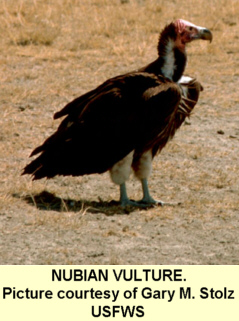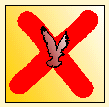
LAPPET-FACED VULTURE. Torgos
tracheliotus.
IDENTIFICATION. Also known as Nubian, King or African Eared Vulture, this is the largest of the African Vultures.
The name Lappet-faced Vulture comes from the loose skin (lappets) which hang from the red/pink featherless head. The body plumage is chestnut brown with white down on the upper part of the legs. The bare part of the legs and talons are a grey/blue colour.
IN FLIGHT. The Nubian Vulture relies on soaring flights to find food, using its large wingspan to find warm thermal updrafts.
DISTRIBUTION. Sahara, Somalia, Ethiopia, Masai Mara, South/North West Africa and the Cape. An occasional visitor to Egypt and the Pyrenees. Also found in Israel. Preferring semi-dessert and scrub.
WHEN SEEN. All year round often in group of one hundred or more.
FOOD. Carrion. Will also take bird eggs, insects, small mammals and even other birds such as Flamingo.
BREEDING. May-September. 1 egg laid in a large stick nest in a tree or on a rock ledge. The egg is incubated for approximately 2 months. Flying takes place at 4 months old finally leaving the parent 3 to 6 weeks later.
SIZE. 100-115 cm (40-45 inches)
WINGSPAN. 260cm (102 inches)
WEIGHT. Circa 7kg (15lbs)
CALL. Hisses, grunts and yelps.
FALCONRY.
Not generally used in Falconry.
Falconry
marks
